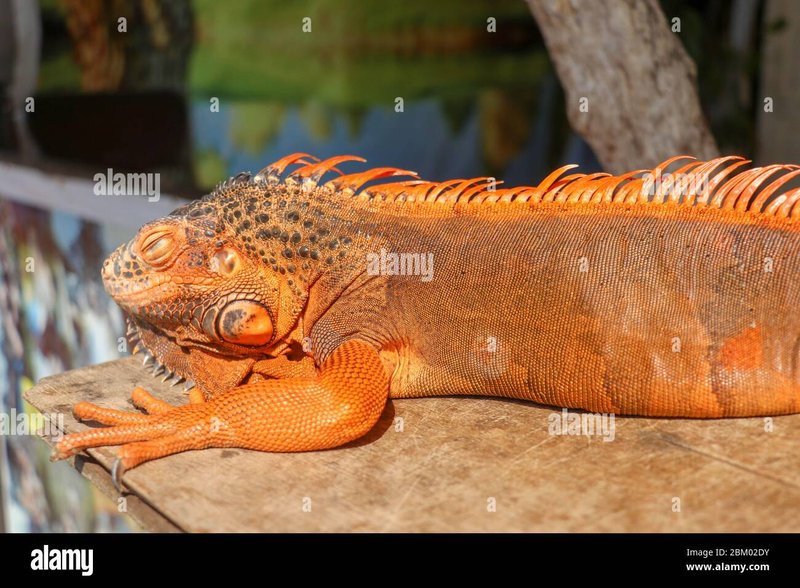
In this guide, we’ll dive into the world of red iguanas, exploring their unique features, habits, and habitats. Think of it like a friendly coffee chat where I share everything I know about these remarkable reptiles. Whether you’re curious about their physical traits, their behavior, or how they compare to other iguana species, we’ve got it all covered.
What is a Red Iguana?
Red iguanas are not a separate species but rather a color variant of the common green iguana, scientifically known as *Iguana iguana*. These reptiles owe their striking coloration to selective breeding, making them popular pets. While they are often dubbed “red,” their hues can range from deep terracotta to soft pink.
When you first see a red iguana, you might notice its large, robust body and long tail. They can grow to an impressive size, often reaching lengths of up to 6 feet when fully grown. Despite their size, they’re generally gentle and can be quite docile with proper handling. In the wild, they inhabit lush tropical areas, where they thrive in the warm sun and abundant foliage.
Physical Characteristics of Red Iguanas
Identifying a red iguana involves more than just noting its color. These reptiles have distinct physical features that set them apart from other iguanas. First off, their scales are usually smooth and shiny, contributing to their eye-catching appearance. The vibrant red or orange coloration typically starts to show when they are around 3 to 5 months old, making them a stunning sight as they mature.
Another key feature is their dewlaps, the flap of skin beneath their chins. In males, the dewlap is usually larger and more pronounced, which plays a role in attracting mates and displaying dominance. Additionally, their spines—the long, pointed scales that run down their backs—are quite prominent and often lighter than the main body color, providing a striking contrast.
It’s also important to mention their eyes. A healthy red iguana will have bright, clear eyes. If you’re looking to identify one, check for any signs of cloudiness or redness, which can indicate health issues.
Behavior and Habits of Red Iguanas
Understanding the behavior of red iguanas can help you identify them better. These reptiles are primarily herbivorous, meaning their diet mainly consists of leaves, flowers, and fruits. You might find them basking in the sun for hours, a common behavior because they are ectothermic. In simple terms, they rely on external sources to regulate their body temperature.
Red iguanas are also known for their climbing skills. You’ll often see them lounging on branches in trees, which provides them with a safe spot from predators. If you observe a red iguana in its natural habitat or in a well-designed enclosure, you might notice how gracefully they navigate through the foliage.
Socially, red iguanas can be solitary. However, they may display territorial behavior, especially males during breeding season, making them somewhat competitive. Watching their interactions can be fascinating, especially if you’re lucky enough to see them engage in head-bobbing or other courtship rituals.
Habitat and Distribution
Red iguanas are mostly found in tropical and subtropical regions of Central and South America. Countries like Costa Rica, Brazil, and Panama are their natural homes, where they thrive in lush rainforests and near rivers. The humidity and warmth of these environments suit their biological needs perfectly, supporting their growth and health.
In captivity, however, ensuring the right environment is crucial for their well-being. If you’re thinking about having a red iguana as a pet, you should replicate their natural habitat as closely as possible. This includes providing a UVB light source, suitable humidity levels, and plenty of climbing structures. Understanding their natural habitat helps not only in identification but also in proper care.
Differences Between Red Iguanas and Green Iguanas
You might be wondering how to tell a red iguana apart from its green counterpart. While both are from the same species, there are significant differences in appearances and care needs. Color is the most obvious distinction. Green iguanas are primarily green, while red iguanas display a stunning mix of reds, oranges, and even yellows.
Behaviorally, their temperaments can also vary. Some owners report that red iguanas tend to be more laid-back compared to green iguanas, which can be skittish. In terms of care, while both need a similar diet, the red iguana’s reproductive traits may require more attention, especially if you have male and female iguanas.
Another aspect to consider is their price. Because red iguanas are bred for their color, they often come with a higher price tag than green iguanas. If you’re considering one, be prepared for this investment.
Caring for a Red Iguana
If you’re thinking of owning a red iguana, knowing how to care for them is essential. These reptiles require specific conditions to thrive. Start with their habitat: an enclosure that’s tall rather than wide will mimic their natural inclination to climb. Provide plenty of branches and foliage to explore.
Diet is another critical factor. They thrive on leafy greens, fruits, and vegetables. Offering a variety of options ensures they get essential nutrients. Avoid feeding them high-protein foods like insects, as these can cause health issues.
Lastly, temperature is vital. A basking spot should be around 100°F, with cooler areas allowing for temperature regulation. Regular vet check-ups can help identify any potential health issues early on.
Identifying a red iguana is all about appreciating their stunning features and understanding their needs. From their vibrant colors to their fascinating behaviors, these reptiles have a lot to offer. Whether you’re observing one in the wild or considering them as a pet, knowing how to recognize and care for them is key.
With the right environment, a balanced diet, and a little patience, owning a red iguana can be a rewarding experience. Just remember, they might be a little challenging at times, but their beauty and uniqueness make every effort worthwhile. If you’re ever unsure about anything, don’t hesitate to reach out to fellow reptile enthusiasts or professionals. Happy herping!

